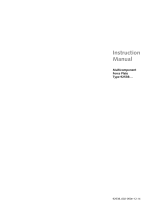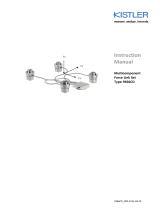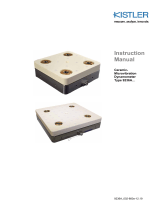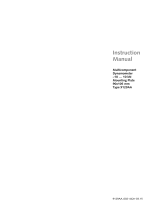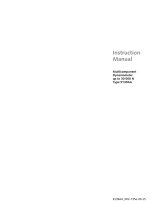Page is loading ...

Instruction
Manual
Multicomponent
Force Plate with
Glass Top Plate
Type 9285B…
ä
9285B_002-499e-02.10

Instruction
Manual
Multicomponent Force
Plate with Glass Top
Plate
Type 9285B…
ä
Multicomponent
Force Plate with
Glass Top Plate
Type 9285B…
ä
9285B_002-499e-02.10


Foreword
Foreword
We thank you for choosing a Kistler quality product
distinguished by technical innovation, precision and long
life.
Information in this document is subject to change without
notice. Kistler reserves the right to change or improve its
products and make changes in the content without
obligation to notify any person or organization of such
changes or improvements.
© 2010 Kistler Group. All rights reserved. Except as
expressly provided herein, no part of this manual may be
reproduced for any purpose without the express prior
written consent of Kistler Group.
Kistler Group
Eulachstrasse 22
8408 Winterthur
Switzerland
Tel. +41 52 224 11 11
Fax +41 52 224 14 14
www.kistler.com
9285B_002-499e-02.10 Page 1

Multicomponent Force Plate with Glass Top Plate Type 9285B…
Content
1. Introduction ................................................................................................................................... 4
2. Important Information.................................................................................................................... 5
2.1 For Your Safety .................................................................................................................... 5
2.2 ä-Conformity..................................................................................................................... 6
2.3 How to Treat the Instrument................................................................................................ 6
2.4 With External Amplifier (Type 9285B…) .............................................................................. 6
2.5 Hints for Using the Operating Instructions ........................................................................... 7
2.6 What Happens After Modifications? .................................................................................... 7
2.7 Disposal Instructions for Electrical and Electronic Equipment ................................................ 7
3. General Description of the Instrument........................................................................................... 8
3.1 Introduction ......................................................................................................................... 8
3.2 Assembly of the Force Plate ............................................................................................... 10
4. Mounting, Installation and Putting into Operation...................................................................... 13
4.1 General Hints ..................................................................................................................... 13
4.2 Installation Modes.............................................................................................................. 13
4.3 Installing Mounting Frame for Photographic Applications .................................................. 13
4.4 Installing the Force Plate .................................................................................................... 16
4.5 Basic Circuitry and Cabling of the Measuring System ......................................................... 20
4.6 Connections with Built-In Amplifier (Type 9285B...)........................................................... 21
4.6.1 Connector of Force Plate Type 9285B... with Built-In Amplifier............................. 22
4.6.2 Cable Type 1758A................................................................................................. 23
4.6.3 Digital Control....................................................................................................... 24
5. Operation..................................................................................................................................... 25
5.1 Range Selection.................................................................................................................. 25
5.2 Operate/Reset ................................................................................................................... 25
5.2.1 Balance Analysis, Posturography ........................................................................... 26
5.3 Usable Frequency Range.................................................................................................... 26
5.4 Temperature Influences...................................................................................................... 27
5.5 Polarity of the Measuring Signal......................................................................................... 27
5.5.1 x- and y-Directions................................................................................................ 27
5.5.2 z-Direction ............................................................................................................ 27
6. Maintenance ................................................................................................................................28
6.1 Recalibration of the Instrument .......................................................................................... 28
6.2 Weekly Function Check...................................................................................................... 29
6.2.1 System Check........................................................................................................ 29
6.2.2 Drift Check............................................................................................................ 29
6.2.3 Check Gap Around Force Plate.............................................................................. 29
6.2.4 Setup Parameters .................................................................................................. 29
6.3 Maintenance ...................................................................................................................... 30
6.4 Cleaning and Sterilization................................................................................................... 30
Page 2 9285B_002-499e-02.10

Content
9285B_002-499e-02.10 Page 3
7. Troubleshooting ...........................................................................................................................31
7.1 Defective Force Plate ..........................................................................................................31
8. Technical Data ..............................................................................................................................32
8.1 Dimensions and Connections..............................................................................................32
8.2 Technical Data for Type 9285B...........................................................................................33
8.2.1 General ..................................................................................................................33
8.2.2 Built-In 8 Channel Charge Amplifier.......................................................................35
9. Glossary........................................................................................................................................36
9.1 Coordinate System..............................................................................................................36
9.2 Kistler Coordinate System ...................................................................................................36
9.2.1 ISB Coordinate System ...........................................................................................37
9.3 Parameters Calculation........................................................................................................37
10. Warranty.......................................................................................................................................38
11. Declaration of Conformity ............................................................................................................39
Total pages 40

Multicomponent Force Plate with Glass Top Plate Type 9285B…
1. Introduction
Please take the time to thoroughly read this instruction
manual. It will help you with the installation, maintenance,
and use of this product.
To the extent permitted by law Kistler does not accept any
liability if this instruction manual is not followed or
products other than those listed under Accessories are
used.
Kistler offers a wide range of products for use in measuring
technology:
Piezoelectric sensors for measuring force, torque, strain,
pressure, acceleration, shock, vibration and acoustic-
emission
Strain gage sensor systems for measuring force and
moment
Piezoresistive pressure sensors and transmitters
Signal conditioners, indicators and calibrators
Electronic control and monitoring systems as well as
software for specific measurement applications
Data transmission modules (telemetry)
Kistler also develops and produces measuring solutions for
the application fields engines, vehicles, manufacturing,
plastics and biomechanics sectors.
Our product and application brochures will provide you
with an overview of our product range. Detailed data
sheets are available for almost all products.
If you need additional help beyond what can be found
either on-line or in this manual, please contact Kistler's
extensive support organization.
9285B_002-499e-02.10 Page 4

Important Information
2. Important Information
Please keep to the following rules without fail. This will
ensure your personal safety when working, and assure
long, trouble-free performance by the instrument.
2.1 For Your Safety
This instrument has been tested thoroughly and it left
the works in a perfectly safe condition. To maintain this
condition and assure safe operation, the user must
observe the directives and warnings contained in these
instructions
The force plate must be installed, operated and
maintained only by persons who are familiar with it and
adequately qualified for their particular tasks
When it must be assumed that safe operation is no
longer possible, the instrument must be taken out of
operation and secured against unintentional use
It must be assumed that safe operation is no longer
possible if:
the instrument is visibly damaged
it no longer functions
it has been in lengthy storage under adverse conditions
it has received rough treatment during transport
According to safety requirements the following has to be
observed:
Caution!
Please mount the force plate on its foundation
following the instructions in chapter 4 "Assembly,
installation and putting into operation".
According to safety requirements the following has to be
observed:
The force plate has to be connected to earth using the
Potential Equalization Conductor provided in the scope
of delivery to meet the ä-standards regarding Earth
Leakage Current.
The data acquisition computer and persons who are in
direct contact with it have to remain in a distance of
1,5 m from the patient at all times for the same reason.
9285B_002-499e-02.10 Page 5

Multicomponent Force Plate with Glass Top Plate Type 9285B…
2.2 ä-Conformity
The Force Plate Type 9285B… is conforming to ä
directives according to the Declaration of Conformity
enclosed with these operating instructions.
2.3 How to Treat the Instrument
The force plate may be used only under the specified
environmental and operating conditions
Protect the signal output against dirt and do not touch
it with your fingers. When the connection is not being
used, cover it with the cap provided
When the force plate is not in use, protect it by keeping
it in the packing case supplied
When performing long-time measurements, make sure
that the temperature of the force plate remains as
constant as possible
2.4 With External Amplifier (Type 9285B…)
The insulation resistance is crucially important with
piezoelectric measurements. It must be around 100 TΩ
(but at least 10 TΩ).
To obtain this resistance, all plug and socket connections
must be kept meticulously clean and dry.
The insulation resistance can be measured with the
insulation tester Type 5493.
The connecting cable from force plate to charge amplifier is
highly insulating. Use only the proper cable.
Do not remove the connecting cable from the force plate.
Page 6 9285B_002-499e-02.10

Important Information
2.5 Hints for Using the Operating Instructions
We recommend reading the entire Instruction Manual as a
matter of principle. If you're in a hurry, however, and
you've already gathered experience with Kistler force
plates, you can confine your reading to the information
that you really need.
We have endeavored to arrange these instructions so that
you can find the information you need without difficulty.
Please keep these Operating Instructions in a safe place
where they can be consulted any time.
If the instructions get lost, just turn to your Kistler
distributor and they will be replaced without delay.
All information and directives in these instructions may be
modified at any time without prior notification.
2.6 What Happens After Modifications?
Modifications to instruments result in alterations of the
operating instructions as a rule. In such cases, enquire at
your Kistler distributor about the possibilities of updating
your documentation.
2.7 Disposal Instructions for Electrical and Electronic Equipment
Do not discard old electronic instruments in municipal
trash. For disposal at end of life, please return this
product to an authorized local electronic waste disposal
service or contact the nearest Kistler Instrument sales
office for return instructions.
9285B_002-499e-02.10 Page 7

Multicomponent Force Plate with Glass Top Plate Type 9285B…
3. General Description of the Instrument
3.1 Introduction
The multicomponent force plate Type 9285B… is a
piezoelectric sensor assembly that allows the following
measurands to be recorded:
The 3 components Fx, Fy and Fz of a force F applied to
the plate
The 3 components Mx, My and Mz of the resultant
moment vector M relative to the origin of the
coordinate system
Provided no tensile stresses can act on the top plate in the
z-direction, the following can also be determined:
The 2 coordinates ax and ay of the center of pressure on
the surface of the plate and
the free moment Mz about an axis normal to the
surface of the plate
The electric charges yielded by the force plate are strictly
proportional to the measurands. They are converted by
charge amplifiers into analog DC voltages for recording,
display or other processing as required.
This force plate has the following special features:
Wide measuring and frequency range
High rigidity and hence minute measuring deflections
High degree of overload protection
Glass top plate allows photographing of the contact
surface from the underside (at the same time as force
measurement)
Corrosion-resistant construction
Connection of force plate with a metal-sheathed 8-pole
cable with multipole connector
Typical applications for the force plate include:
Biomechanics: gait analysis and animal studies
Sport: motion analysis and training
Orthopedics: rehabilitation and fitting of prostheses
Neurology: posturography and microvibrations
Page 8 9285B_002-499e-02.10

General Description of the Instrument
Fig. 1: Multicomponent force plate for biomechanics
Type 9285B…
9285B_002-499e-02.10 Page 9

Multicomponent Force Plate with Glass Top Plate Type 9285B…
3.2 Assembly of the Force Plate
Assembly of the force plate.
Fig. 2: Cross section through the force plate
1 3 component force measuring elements (force links)
2 Mounting base
3 Pressure pads
4 Hollow bolt
5 Top plate, replaceable
5 Cable channel
6 Flange
7 Decoupling piece
8 M12x50 hexagon bolt with hexagon socket
9 Washer
10 M12x35 fixing bolt with hexagon socket
11 Cylinder head screw with hexagon socket
Page 10 9285B_002-499e-02.10

General Description of the Instrument
Fig. 2 shows the force plate assembly. Each pair of 3-
component force links Type 9067 or 9068 (1) are mounted
between the Force plate frame (2) and the four pressure
pads (3) with four hollow bolts (4)$$, each with a preload of
160 kN. The replaceable top plate (5) is screwed down onto
the four pressure pads (3).
The flange (6) is connected to the pressure pad (3) in such a
way as to avoid any unwanted resultant force on the hollow
bolt (4). The decoupling piece (7) and the hexagon bolts (8)
secure the top plate (5) to the force plate frame (2). The
washer (9) is fitted to reduce the friction on the head of the
hexagon bolt.
The force plate is mounted with four high-strength M12x35
fixing bolts with hexagon sockets threaded through the
hollow bolts.
All of the gaps and openings are filled with Sylgard 170 to
enable the entire surface of the top plate to be used for the
measurements.
9285B_002-499e-02.10 Page 11

Multicomponent Force Plate with Glass Top Plate Type 9285B…
Fig. 3: Assembly and dimensions
Page 12 9285B_002-499e-02.10

Mounting, Installation and Putting into Operation
4. Mounting, Installation and Putting into Operation
4.1 General Hints
The force plate Type 9285B… is a measuring
instrument whose accuracy can only be fully exploited
if it is mounted and handled with appropriate care.
In particular, it must be mounted exactly to
specification to avoid being damaged by overloads
(such as excessive internal stresses, etc.).
For nonobservance of the mounting instructions Kistler
will decline all responsibility.
4.2 Installation Modes
The force plate Type 9285B… may be set up in position in
principle.
The special advantage of piezoelectric force measure-
ment – minimal measuring deflections even with the
highest forces, i.e. high rigidity – requires mounting the
force plate on a suitably rigid and level surface.
4.3 Installing Mounting Frame for Photographic Applications
A great advantage of this force plate is that it offers the
possibility of photographic observation from below the
measuring procedure. Fig. 4 shows a special mounting
frame for this purpose.
Procedure for grouting-in the Type Z12627 mounting
frame
Position the frame on the prepared concrete base,
centered on it's recess
Level off the frame in height so that the force plate
surface is flush afterwards with the surrounding surface,
allowing for any covering to be added later
Grout-in frame with synthetic resin mortar:
not higher than top of square tube
not lower than about 5 mm above U-profile
9285B_002-499e-02.10 Page 13

Multicomponent Force Plate with Glass Top Plate Type 9285B…
Important
The force plate is not suitable for outdoor use.
A gap of at least 2 mm must be left free between the
force plate and the surrounding floor. Floor coverings
such as Tartan or other types of surfacing must also be
interrupted at the edge of the force plate to avoid a
force bypass
Page 14 9285B_002-499e-02.10

Mounting, Installation and Putting into Operation
Fig. 4: Foundations with mounting frame for
photographic applications (suggested
arrangement)
9285B_002-499e-02.10 Page 15

Multicomponent Force Plate with Glass Top Plate Type 9285B…
4.4 Installing the Force Plate
Once the mortar has set, the plate (and any mirror) can be
mounted.
Mounting procedure (see Fig. 2 … 6)
The assembly must be prepared for mounting by removing
the glass top plate, the decoupling pieces and the flanges
one after the other:
The glass top plate is screwed down onto the flange
(item 6 in Fig. 2) with an M12x50 hexagon bolt (item 8
in Fig. 2). After undoing the four screws with hexagon
socket the top plate can be lifted off by the included
eyebolts
The four decoupling pieces (item 7 in Fig. 2) between
top plate and flange can now be removed
To gain access to the fixing bolt (item 10 in Fig. 2), the
flange (item 6 in Fig. 2), which is attached to the
pressure pad (item 3 in Fig. 2) with six cylinder head
screws (item 11 in Fig. 2), must be removed
The M12x35 fixing bolt (item 10 in Fig. 2) is now
accessible and the force plate frame (item 2 in Fig. 2)
can be mounted on the mounting frame
Fig. 5: Mounting frame onto base support
Page 16 9285B_002-499e-02.10

Mounting, Installation and Putting into Operation
Mounting force plate
Lay the force plate frame on the mounting frame in its
mounting position as shown in Fig. 5:
Press down on alternate diagonally opposite
corners of the force plate frame to check whether
it is lying evenly on the mounting frame. Any
rocking is clearly evident
If rocking is felt, the force plate frame must be
raised and one of the included shims inserted
underneath. If the thinnest shim is too thick, a
piece of aluminum foil may provide a suitable
remedy. Only ever shim frame at one corner
After carrying out the above steps connect cable and
screw the force plate frame down on the mounting
frame with the included M12x35 fixing bolts (item 10
in Fig. 2) (Ttightening = 90 N·m)
A hexagon socket key for tightening the M12x35 bolts to a
torque of 90 N·m is included. Screws and bolts must be
greased sparingly.
Once the force plate frame has been mounted on the
mounting frame the retaining bar can be removed
Each of the flanges (item 6 in Fig. 2) is now attached to
the force links with the six cylinder head screws (item
11 in Fig. 2)
The decoupling pieces (item 7 in Fig. 2) must be
carefully positioned before the glass plate is mounted
The top plate (item 5 of Fig. 2) is then carefully located
on the decoupling pieces. The top plate can be raised
and lowered by the included eyebolts. Four threads are
provided in the steel inserts in the surface of the top
plate
The four washers (item 9 in Fig. 2) are then inserted
and the top plate secured with the four M12x50
hexagon bolts (item 8 in Fig. 2)) (Ttightening = 60 N·m).
The bolts must be greased sparingly
9285B_002-499e-02.10 Page 17
/




